c.
The AR(2) process
The
AR(2) process is defined as

(V.I.1-94)
where
Wt is a stationary time series, et is a white
noise error term, and Ft is the forecasting
function.
The
process defined in (V.I.1-94) can be written in the form

(V.I.1-95)
and
therefore

(V.I.1-96)
Now,
for (V.I.1-96) to be valid, it easily follows that

(V.I.1-97)
and
that

(V.I.1-98)
and
that

(V.I.1-99)
and
finally that

(V.I.1-100)
The
model is stationary if the yi
weights converge. This is the case when some conditions on f1
and f2
are imposed. These conditions can be found on using the solutions of
the polynomial of the AR(2) model. The so-called characteristic
equation is used to find these solutions

(V.I.1-101)
The
solutions of x1
and x2
are

(V.I.1-102)
which
can be either real or complex. Notice that the roots
are complex if

When
these solutions, in absolute value, are smaller than 1, the AR(2)
model is stationary.
Later,
it will be shown that these conditions are satisfied if f1
and f2
lie in a (Stralkowski) triangular
region restricted
by

(V.I.1-103)
The
derivation of the theoretical
ACF and PACF for an AR(2) model is described below.
On
multiplying the AR(2) model by Wt-k, and taking
expectations we obtain

(V.I.1-104)
From
(V.I.1-97) and (V.I.1-98) it follows that

(V.I.1-105)
Now
it is possible to combine (V.I.1-104) with (V.I.1-105) such that

(V.I.1-106)
from
which it follows that

(V.I.1-107)
Therefore
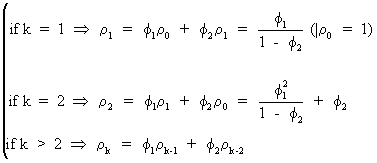
(V.I.1-108)
Eq.
(V.I.1-106) can be rewritten as

(V.I.1-109)
such
that on using (V.I.1-108) it is obvious that

(V.I.1-110)

According
to (V.I.1-107) the ACF is a second order stochastic difference
equation of the form

(V.I.1-111)
where
(due to (V.I.1-108))
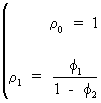
(V.I.1-112)
are
starting values of the difference equation.
In
general, the solution to the difference equation is, according to
Box and Jenkins (1976), given by
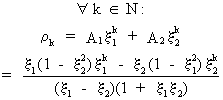
(V.I.1-113)


In
particular, three different cases can be worked out for the
solutions of the difference equation

(V.I.1-114)

of
(V.I.1-102). The
general solution of eq. (V.I.1-113) can be written in the form

(V.I.1-115)


(V.I.1-116)
Remark
that for the case the following stationarity conditions
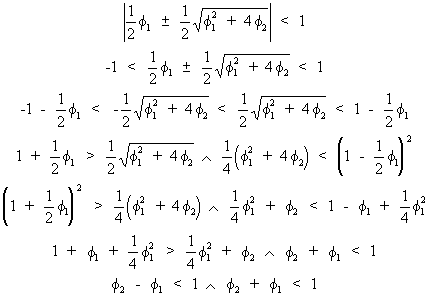
(V.I.1-117)




(V.I.1-118)
has
two solutions

due
to (V.I.1-114)
and

due
to
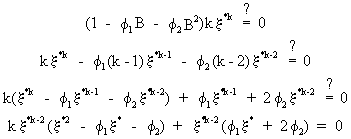
(V.I.1-119)

Hence
we find the general solution to the difference equation

(V.I.1-120)
In
order to impose convergence the following must hold

(V.I.1-121)
Hence
two conditions have to be satisfied
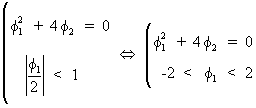
(V.I.1-122)
which
describes a part of a parabola consisting of acceptable parameter
values for

Remark
that this parabola is the frontier between acceptable real-valued
and acceptable complex roots (cfr. Triangle of Stralkowski).


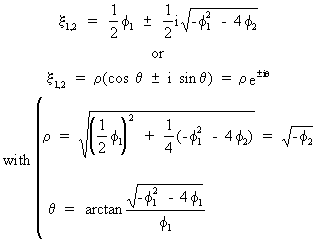
(V.I.1-123)
in
goniometric notation.
The
general solution for the second-order difference equation can be
found by

(V.I.1-124)
On
defining

(V.I.1-125)
the
ACF can be shown to be real-valued since
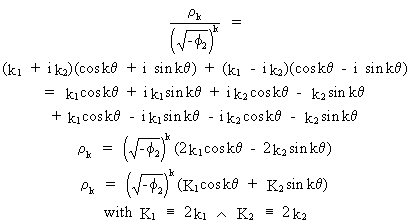
(V.I.1-126)
On
using the property

(V.I.1-127)
eq.
(V.I.1-126) becomes

(V.I.1-128)
with
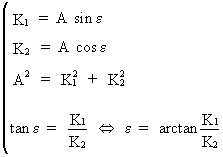
(V.I.1-129)
In
eq. (V.I.1-128) it is shown that the ACF is oscillating with period Ã
= 2p/q
and
a variable amplitude of

(V.I.1-130)
as
a function of k.
A
useful equation can be found to compute the period of the pseudo-periodic behavior of the time series as

(V.I.1-131)
which
must satisfy the convergence condition (c.q. the amplitude is
exponentially decreasing)

(V.I.1-132)

The
pattern of the theoretical
PACF can be deduced from relations (V.I.1-25) -
(V.I.1-28).
The
theoretical ACF and PACF are illustrated below. Figure (V.I.1-2)
contains two possible ACF and PACF patterns for real roots while
figure (V.I.1-3) shows the ACF and PACF patterns when the roots are
complex.
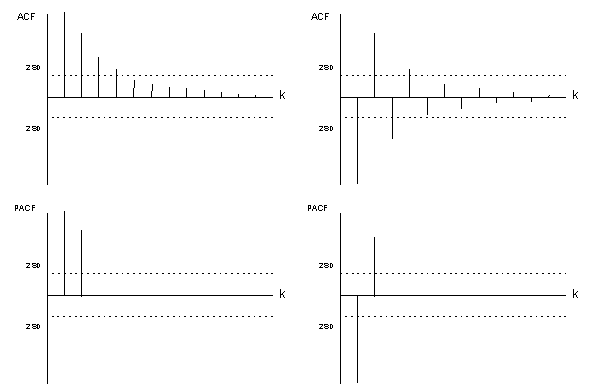
(figure
V.I.1-2)
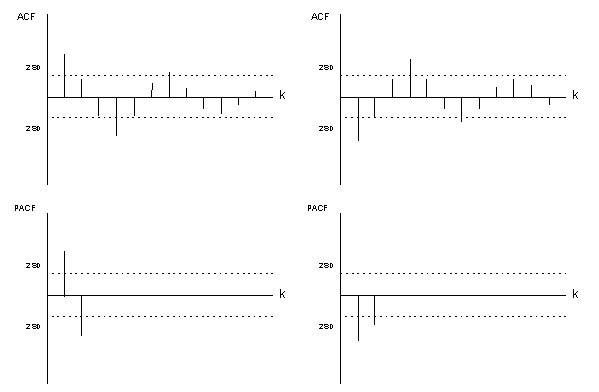
(figure
V.I.1-3) | 
